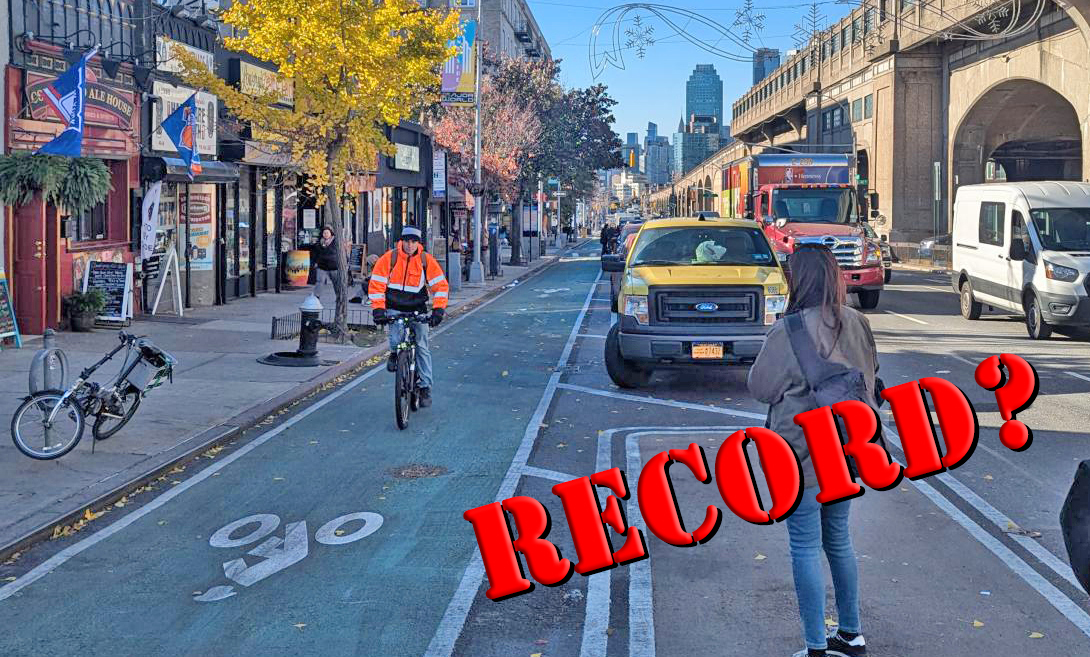 The Central Park loop drive was never meant for traffic. Photo: Frodrig/Flickr
The Central Park loop drive was never meant for traffic. Photo: Frodrig/FlickrThe city's ongoing effort to have it both ways in Central Park resulted in another near-tragedy last week.
Brian Dooda was riding his bike in the park when he got into an altercation with the driver of an SUV. It seems Dooda was not riding in the "recreational lane" that the city has thoughtfully provided for those who have the quaint notion that Central Park is a place to escape the urban din. Instead, Dooda was out in one of the traffic lanes, "keeping a steady pace of 25 mph" as he later reported on the New York Cycle Club's message board.
Going the legal speed limit in Central Park apparently wasn't good enough for the SUV driver, who shared his displeasure with Dooda by cutting across his path, reportedly missing Dooda's front wheel by inches. Dooda caught up to the driver at a light. What allegedly unfolded is vividly described on Dooda's NYCC post, but in abbreviated form Dooda says the driver intentionally drove into him twice, with Dooda ending up on the car's hood and being driven some 200 feet while pleading for his life. Dooda says he finally fell off, essentially unharmed, and the driver sped away. There were witnesses, the license plate number was taken down, and Dooda has filed a report with the police.
Accounts of the incident on Gothamist and Gawker have elicited the usual quotient of "all cyclists deserve to die because a messenger hit me once" comments. Others piled on with their own "I told you so's" following the revelation that the SUV driver was a Fox News writer named Don Broderick (who apparently is using the "he hit me first" defense).
But all this finger-pointing and name-calling misses a larger issue. As most of us know, recreational users of Central Park have been unhappily sharing the park's loop road with car traffic for decades. This was the road that the park's designers, Frederick Law Olmsted and Calvert Vaux, intended to be an integral part of the park experience and to never serve as a traffic thoroughfare. They won the competition to design Central Park precisely because they devised an ingenious way of allowing traffic to cross the park unnoticed via the four transverses.
Over the years, Central Park's recreational users have clawed back much car-free time, literally hour by hour. But as someone who has spent thousands of hours out on the loop road, I can report that clashes between drivers and park-goers -- ranging from horn honking to curses to threats -- occur with unsurprising frequency. The Dooda-Broderick incident made it beyond the park's boundaries only because of the egregiousness of Broderick's alleged actions. It stands as the latest stark reminder that Central Park's loop road cannot be both a refuge and a commuting corridor.
The city administration is boldly closing roads ranging from Park Avenue to Broadway to fulfill Mayor Bloomberg's vision of a "greener, greater New York City," but it still clings to the myth that cars must invade Manhattan's original green road, one that was never meant for traffic in the first place.
Sources within City Hall say that potential spillover traffic in Harlem is the only thing standing between New Yorkers and a car-free park. In fact, Harlem is the neighborhood that has the most to gain from a car-free park. A 2007 Transportation Alternatives study found that 57 percent of private car traffic using the park's northern entrances originates outside of Harlem. Closing the park to traffic would remove hundreds of cars from Harlem's streets and reduce tailpipe emissions in the neighborhood by about 3,240 pounds each day.
Until officials summon the small measure of political will needed to return the loop road to its rightful users, it will continue to be a contested street to which both drivers and park users believe they have a righteous claim. And the next Brian Dooda may not be so lucky.





